AASP Newsletter - July 2020
Young Writer's Corner: Staying Connected to Your Sport - Imagery Use During COVID-19
 Katherine Hirsch |
 Seth Rose |
 Dhruv Raman |
Seth Rose, MS, CMPC, PhD Candidate, University of Idaho
Dhruv Raman, MEd Candidate, Boston University
Athletes often experience adversity in training and competition. However, the COVID-19 pandemic has challenged athletes with unexpected, high-intensity adversity resulting from diminished resources, including reduced access to training equipment, training facilities, coaching staff, and peers. However, athletes do experience similar challenges and restrictions when overcoming injuries or training during the off-season. An injury can prevent an athlete from engaging in sport-specific tasks and the off-season can isolate athletes from teammates and reduce team cohesion. As a result, athletes can experience negative outcomes such as apprehension about returning to sport (Podlog, Dimmock, & Miller, 2011), reduced physical strength (Minett, Binkley, Weidauer, & Specker, 2017), or depression (Appaneal, Levine, Perna, & Roh, 2009).
When dealing with training restrictions imposed by injury or the off-season, researchers have recommended imagery as a method to help athletes cope (Cupal & Brewer, 2001; Miller & Munroe-Chandler, 2019).
Specific guidelines include:
- Relaxed state and distraction-free environment. Imagery is most effective when an athlete approaches practice in a relaxed state, with a quiet, distraction-free mind. Alpha waves in the brain are associated with deep relaxation and aid in imagery techniques (Vealey & Forlenza, 2015). Specific suggestions to achieve a relaxed state and distraction-free environment include finding a quiet space, closing your eyes, and then focusing on your breathing before starting to imagine.
- Vividness. Using images with increased detail and reality can enhance the vividness and the effectiveness of your images (Jeannerod, 1994). For example, imaging the layout of a training facility, or the scenery at a competition can aid in imaging a detailed, realistic image. Visual and auditory senses are best for beginners to practice until a clear picture and distinguishable sounds can be achieved. Following visual and auditory details, other senses such as kinesthetic (e.g., a diver moving their arms to mimic their dive), olfactory (e.g., smelling the freshly cut grass of the soccer field), and gustatory (e.g., sweat dripping down your face onto your lips) can be added to increase vividness. Individuals who have trouble with vividness can watch video footage of themselves or others performing the task they are trying to image (Ives, Straub, & Shelley, 2002).
- Controllability. Imagery includes exercising control over the imaged task, outcome, perspective, and speed. Training controllability can help athletes to better manipulate images, and achieve an optimal state, perspective, or outcome. Imaging and controlling a task to success or imaging a mistake and rewinding the task to replay it in a better way, can increase confidence to perform when sport resumes (Williams, Zinsser, & Bunker, 2014). Moreover, controlling the speed of the image in various ways (e.g., real-time, slow motion, and fast forward), can aid in the effectiveness of imagery and contribute to an athlete’s dynamic training by focusing attention on different aspects of their sport in a variety of situations (Vealey & Forlenza, 2015). For example, a Nordic ski athlete could utilize multiple speeds across their imaging of a long event by implementing real-time imaging for the start of the race, and then switching to fast-forward for the remainder of the race.
- Perspective. Imagery perspective is when an athlete views their image from either an internal or external point of view. Research shows both internal (Wright & Smith, 2009) and external (Hardy & Callow, 1999) perspectives are effective, and with practice, more experienced performers could benefit from switching between the perspectives while imaging (Smith, Collins, & Hale, 1998).
Incorporating daily imagery training, consistent with workouts and recovery, can aid in athletic gains such as increased performance or enhanced learning of skills (see Smith, Wright, Allsopp & Westhead, 2007) during the current pandemic and other times of reduced sport access.
Here are some additional tips for novice or student practitioners beginning to implement imagery practice:
- Start with what you know.
If an athlete is trying imagery for the first time, select image skills, situations, or strategies that are familiar. A familiar image will be easier to imagine and can help the athlete to gain confidence in their imagery ability. - Consider time and speed.
Consider how imaging in real-time, slow motion or fast pace could be beneficial for various images and scenarios. For instance, while imaging is a well-known skill it is advised to image in real-time. Alternatively, when imaging a new skill, slow motion may be best (Holmes & Collins, 2001). Finally, if some parts of an athlete’s imagery are less crucial than others—such as walking toward the playing field—it may be beneficial to image at a faster pace. - Consider emotions and feelings.
Think about what emotions and feelings (including physical sensations) might arise in the situation the athlete is imagining. Also, consider emotions and feelings that would be desirable in this situation. Try to incorporate those emotions, as well as regulation strategies as required, within the imagery practice. This can be helpful to prepare for and deal with physiological arousal during competition (Smith et. al, 2007). - Create personalized imagery scripts.
Use the above considerations to write your own script. Record it in your own voice and have the athlete listen to it while imaging. Imagery scripts can provide structure and make it more effective (Williams, Cooley, Newell, Weibull & Cumming, 2013). Here is a resource to help you build your own imagery script. - Enhance with clothing and equipment.
Consider having the athlete in uniform and holding sporting equipment to maximize the effect of their session (Holmes & Collins, 2001). - Use imagery prompts.
Use pictures, videos, and sounds to help with their imagery. For instance, have a picture of their home ground ready before they imagine executing a skill in that environment. - Do it together.
Try conducting a team imagery session with the help of an online script written by the team, coach and/or a Mental Performance Consultant. This can be done remotely over the phone or an online platform.
For more online imagery resources please visit https://appliedsportpsych.org/resources/resources-for-athletes/sport-imagery-training/.
References
Appaneal, R. N., Levine, B. R., Perna, F. M., & Roh, J. L. (2009). Measuring postinjury depression among male and female competitive athletes. Journal of Sport and Exercise Psychology, 31(1), 60-76. https://doi.org/10.1123/jsep.31.1.60
Cupal, D. D., & Brewer, B. W. (2001). Effects of relaxation and guided imagery on knee strength, reinjury anxiety, and pain following anterior cruciate ligament reconstruction. Rehabilitation Psychology, 46(1), 28–43. https://doi.org/10.1037/0090-5550.46.1.28
Hardy, L., & Callow, N. (1999). Efficacy of external and internal visual imagery perspectives for the enhancement of performance on tasks in which form is important. Journal of Sport and Exercise Psychology, 21(2), 95-112. https://doi.org/10.1123/jsep.21.2.95
Holmes, P. S., & Collins, D. J. (2001). The PETTLEP approach to motor imagery: A functional equivalence model for sport psychologists. Journal of Applied Sport Psychology, 13(1), 60-83. https://doi.org/10.1080/10413200109339004
Ives, J. C., Straub, W. F., & Shelley, G. A. (2002). Enhancing athletic performance using digital video in consulting. Journal of Applied Sport Psychology, 14, 237–245. https://doi.org/10.1080/10413200290103527
Jeannerod, M. (1994). The representing brain: Neural correlates of motor intention and imagery. Behavioral and Brain Sciences, 17, 187–202. https://doi.org/10.1017/S0140525X00034026
Miller, M., & Munroe-Chandler, K. (2019). Imagery use for injured adolescent athletes: Applied recommendations. Journal of Sport Psychology in Action, 10(1), 38-46. https://doi.org/10.1080/21520704.2018.1505677
Minett, M. M., Binkley, T. B., Weidauer, L. A., & Specker, B. L. (2017). Changes in body composition and bone of female collegiate soccer players through the competitive season and off-season. Journal of Musculoskeletal & Neuronal Interactions, 17(1), 386–398.
Podlog, L., Dimmock, J., & Miller, J. (2011). A review of return to sport concerns following injury rehabilitation: Practitioner strategies for enhancing recovery outcomes. Physical Therapy in Sport, 12(1), 36-42. https://doi.org/10.1016/j.ptsp.2010.07.005
Smith, D., Collins, D., & Hale, B. (1998). Imagery perspectives and karate performance. Journal of Sports Sciences, 16(1), 103-104.
Smith, D., Wright, C., Allsopp, A., & Westhead, H. (2007). It's all in the mind: PETTLEP-based imagery and sports performance. Journal of Applied Sport Psychology, 19(1), 80-92. https://doi.org/10.1080/10413200600944132
Vealey, R. S., & Forlenza, S. T. (2015). Understanding and using imagery in sport. In J. M. Williams & V. Krane (Eds.), Applied Sport Psychology: Personal Growth to Peak Performance, (pp. 240-273). New York, NY: Mc-Graw Hill.
Wright, C. J., & Smith, D. (2009). The effect of PETTLEP imagery on strength performance. International Journal of Sport and Exercise Psychology, 7(1), 18-31. https://doi.org/10.1080/1612197X.2009.9671890
Williams, J. W., Zinsser, N., & Bunker, L. (2014). Cognitive techniques for building confidence and enhancing performance. In J. M. Williams & V. Krane (Eds.), Applied Sport Psychology: Personal Growth to Peak Performance (pp. 274-303). New York, NY: McGraw-Hill.
Williams, S. E., Cooley, S. J., Newell, E., Weibull, F., & Cumming, J. (2013). Seeing the difference: Developing effective imagery scripts for athletes. Journal of Sport Psychology in Action, 4(2), 109-121. https://doi.org/10.1080/21520704.2013.781560



